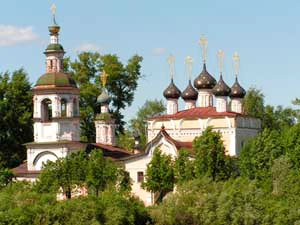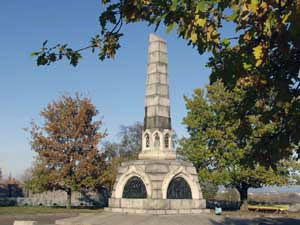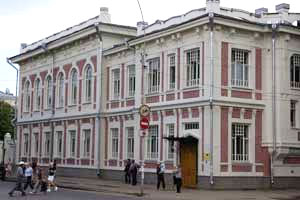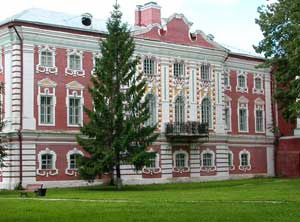Vologda is an administrative centre of the oblast. The first reference to Vologda dates back to 1147. That is why Vologda is called Moscow's contemporary.
Territory: 11,6 thousand hectares
Population: 300,000 people
Location: 460 km to the north of Moscow, 600 km to the south-east of St.Petersburg
Geographic coordinates: latitude 590 13", longitude 390 53"
Transport: a railway station, an airport, a network of highways
River communication: an access to the White Sea via the Vologda river, the Sukhona and the Northern Dvina; an access to the Caspian, the Black Sea and the Mediterranean via the Northern Dvina Channel and the Volga-Baltic water system.

A legend says that the Russian Tsar Ivan the Terrible was going to make Vologda the capital of Russia in the XVIth century. The construction of a «brick town» in Vologda was launched by Ivan the Terrible in 1566. The Vologda Kremlin was originally meant to become a Tsar Residence since Ivan IV wanted to secure himself from a probable rebellion. But something ill-omened occurred: a piece of brick accidentally fell onto the Tsar's head, and he made his getaway to Moscow.
The whole history of Russia might have gone a different way...
The construction of the St.Sophia Cathedral was suspended. It was completed only in the 1630s. Nonetheless, the Vologodians are glad that their native town has not become Russia's capital, — Vologda has preserved intact its historical character, architecture and its original northern style.
The Vologda Kremlin is the chief historical monument and remarkably beautiful ensemble of the past.
Majestic St. Sophia cathedral was built in the pure Byzantine style, while the church tower nearby was built by an European architect in the Gothic style. It must be noted though, it is crowned not with the Gothic steeple, but with the Orthodox «onion» cupola. The two architectural styles, Byzantine and Gothic, co-existed and were apprehended as the signs of the times.
Peter the Great paid much attention to Vologda, especially before Petersburg was laid. However, with the upraise of Petersburg Vologda's significance as a major transport juncture was considerably reduced. At the same time Peter the Great favoured greatly the industrial development of Russia, hence the construction of a number of industrial enterprises in Vologda.
In February, 1918, when «The Brest Truce» had already been established in the war of Russia against Germany, Sir David R. Francis, the then Plenipotentiary and Extraordinary US Ambassador to Russia, came to Vologda. Diplomatic representatives from Japan, China, Siam, and Brazil came along with him.
The decision to stay in Vologda instead of Moscow was made by the US Embassy due to US legal non-recognition of the Soviet Government and discord with the conclusion of Russia's separate peace treaty with Germany. In spite of repeated requests made by Moscow Soviet officials the foreign diplomatic delegation stayed in Vologda till July, 1918 when embassies moved on towards Arkhangelsk.
Foreigners played an important role in the development of the pre-Revolutionary Vologda. A Dane by origin, Theodore Buhmann and his wife Ida introduced rationalism of European science on dairy cattle raising into the Vologda steady way of life. On the site of Buhmann's estate, in 1911 the Russian government founded a specialized Dairy Institute with excellent for those times laboratories and a campus. The Buhmann family's contribution to the development of dairy cattle raising in the Vologda oblast is well-known and publicly recognized. Thanks to their efforts the technology of dairy products processing was perfected.

The famous in Russia «Vologda butter» is also connected with the Buhmann name. In the last century Russian scientist N. Vereshchagin opened a school for peasants in Ida Buhmann's country house and began experiments with dairy sub-products.
Vologda lace has won deserved fame and worldwide recognition for its high artistic value, rich ornament, and excellent workmanship. The earliest laces which have reached us date back to the 17th century. The lace woven from golden and silver threads decorated rich civilian and church garments and was mostly used by the nobility.
By the middle of the 19th century laces had become widely traded. At the beginning of the 20th century Vologda lace gained its distinctive artistic and stylistic features.
At the World Fair in Paris in 1937 the Vologda Lace Association was awarded Grand Prix for the novelty and artistry of its lace articles; at the Brussels Exhibition in 1958 Vologda lace was awarded Gold Medal.
Another popular handicraft, wood-carving, has been practised by Vologodians long since. Carving used to adorn window casings and porches. The art of carvers was so intricate and inventive that there were hardly two patterns alike. Today Vologda preserves fond memory of the past — cosy wooden houses are still can be seen in the streets of the town.
Vologda is the largest in the oblast and one of the most important in the North of Russia junctions of railways, automobile roads and airways. Vologda is a river port which stands on the river with the same name.
Vologda is not only a city of historical and cultural importance It is a major industrial town with numerous enterprises many of which are known for unique technologies and products having no analogues abroad.
Vologda is a machine building and metal processing centre of the oblast. The Vologda optical and mechanical plant, the bearing factory, and the machine-building plant are chief representatives of this industry.
The Vologda lace firm «Snezhinka» is the biggest in Russia. The firm produces lace items woven from flax threads.
There is also a number of food enterprises, the biggest being the Vologda Bakery, the Vologda Dairy, and the greenhouse company «Teplichny» .
The development of Vologda small and medium-size businesses have been boosting considerably.
Vologda is famous for the industrious and talented people it raised. Small wonder, the first Russian ambassador to Great Britain was born and brought up in Vologda.
A Brief History
Foundation of the city of Vologda — 1147.
Foundation of an administrative centre — September 23, 1937.
The history of the city of Vologda begins with the Trinity Monastery raised by the monk Gerasim. This fact was first mentioned in 1147 in the life description of Reverend Gerasim. And the year 1147 is considered to be the foundation date of Vologda. Vologda takes its name from the Vologda River which flows through the city. Its name means «the pure one» in the language of indigenous Finno-Ugric population.
The advantageous geographical location at the intersection of waterways made the city of Vologda an apple of discord and interstine wars in the 13th and 15th centuries. Late in the 14th century Moscow's grand prince Vasily Dmitrievich annexed Vologda to his possessions. Since then Vologda became an appanage of Moscow's princes.
Many princes came to Vologda at that time. And the purpose of their visits was different. Some of them visited the city with good intentions, others robbed, burnt and ravaged the city. But Vologda stood all the adversities and rebuilt the damaged territory. Fortifications, bridges, houses, churches, trade and industrial premises were originally built of wood. Throughout five centuries the Resurrection Church situated on Lenivaya Square was the centre of the city. Stone buildings were erected in the 16th and 17th centuries. The oldest among them is the St.Sophia Cathedral that was founded under tsar Ivan the Terrible in 1565-1570.
The reign of Ivan the Terrible led to the rapid expansion of Vologda. Vologda grew and quickly became one of the most important trade centres of Russia. At that time the city dealt with Siberia via the Sukhona river and the Vychegda, with England, Holland and other countries where the navy routes were laid through the White Sea.

In the 16th century Vologda witnessed a trade boon. Some foreign merchants opened their offices in Vologda. This is what a British trade agent wrote about Vologda in 1554: «This is a big city in the heart of Russia, surrounded by many good cities and towns. There is an abundance of bread here. Nearly every Russian city trades with Vologda.»
Ivan the Terrible visited Vologda on several occasions. He wanted to set up a new residence in the city. A wooden palace and a church were built for the tsar family. The construction of a «brick town» in Vologda was launched by Ivan the Terrible in 1566. The Vologda Kremlin was originally meant to become a Tsar Residence since Ivan IV wanted to secure himself from a probable rebellion. Unfortunately the Mongolian invasion in 1571-1572 into Moscow damaged the construction of the Vologda Kremlin that could compare well with the Moscow Kremlin. A legend says that the Russian Tsar Ivan the Terrible was eager to include Vologda in his private domain or oprichnina (special administrative ?lite). But something ill-omened occurred: a piece of brick accidentally fell onto the Tsar's head, and he made his getaway to Moscow.
During the interregnum known as the Time of Troubles at the beginning of the 17th century the city and the outskirts of it were devastated.
The reign of Michael, first tsar of the Romanov Dynasty was a good time for Vologda. With the return to prosperous trade with Western Europe in the 17th century, the Vologda Kremlin was rebuilt.
In the 17th and 18th centuries the city of Vologda was situated on the both banks of the Vologda River including the Kremlin and 3 posads (craftsmen's districts). The Kremlin was an administrative and trade centre of the city. It also became a military outpost. And it was from the Vologda Kremlin that Peter I started his war compaigns against Sweden which were crowned by glorious victories of the Russian Army and the foundation of St.Peterdburg. The warehouses of Vologda stored military outfit and technical equipment which were brought from Moscow to be transferred to Arkhangelsk where Peter the Great planned to built new fortresses and shipbuilding yards for the Russian navy.
Peter I contributed greatly to the city's heritage. By the middle of the 17th century, Vologda was enjoying great prosperity. It boasted highly developed flax and wood processing, tanning industry and blacksmith's work.
Under the decree of Catherine II Vologda became a centre of the Vologda gubernia (province).
Though over the following centuries the city has been been modified and renovated, the administrative buildings, stone and wooden mansions raised in the 19th century are restored to their original appearance. Construction of a railway line connecting Vologda and Yaroslavl in 1872 boosted the city's development.
Early in the 20th century Vologda became an industrial centre of Russia's North-West. It focused on tanning industry, cloth, sugar and rope production. A locomotive depot, water supply system, telephone office, electric power station were built in the city. Vologda achieved renown of a city of skilled craftsmen. Original and distinctive is lace making.
Now Vologda is an administrative centre with a population of 300,000 people. Vologda's highly skilled workers are employed primarily in industrial plants, service, education, medicine and culture. Produce of the city's enterprises is in high demand in Russia, and has a ready export market in the USA, Finland, Holland, Germany, England and other countries.
The city has become home to the Russian theatrical festival «Voices of History», art festival «Russian North» and numerous exhibitions. No account of Vologda would be complete without mentioning exhibition and fair activity that is held in the city.
There are 224 monuments of history, architecture and culture on the territiry of Vologda (128 monuments are protected by the state).
Vologda is put on the list of 116 Russian cities of priceless historic heritage.
Cultural Institutions
Libraries
The Vologda Regional Academic Library has a collection of about 0,5 million books. It also has its own publishing system, local network and access to the Internet.
Theatres
There are 3 state professional theatres in Vologda:

- Drama Theatre (1, Sovetsky Avenue);
- Theatre for Children and Youth (2, Oktyabrskaya Street);
- Puppet Theatre (21, Lenina Street).
No account of Vologda theartical life would be complete without mentioning the drama festival «Voices of History» . Since 1991 Vologda has been home to the Russian theatrical festival «Voices of History». It is arranged jointly with the RF Ministry of Culture, the RF Union of theatrical workers, the government of the Vologda Oblast and the administration of the city. The festival merits great attention. The success of it has been conditioned by the professionalism of the participants and serious experience, and the ability to combine these qualities with Russian national characteristics. The performances are shown in the open air, in the historical setting of the Vologda Kremlin, which is a point of interest itself. Holding such a festival near the Kremlin is hardly a matter of chance. «The Voices of History» attracted the most skilful actors and repertory theatres from Moscow, St.Petersburg, Novgorod, Pskov, Vladimir, Arkhangelsk and other Russian cities. The judges of the festival are renowned theatrical critics. The focus of the festival is on the history of Russia and the world history.
Besides, the Vologodians have the center of sport and culture «Spektr», the cultural center of the Vologda Bearing Factory, ballet school, chorus, chamber orchestra, children's art groups, the organizations of Russian Artists' Union and Russian Writers' Union.
Museums

- Museum of diplomatic corps (35, Gertsena Street)
- Vologda State Museum-Preserve of History, Architecture and Decorative Arts (15, Orlova Street), which includes:
- Museum of Architecture and Ethnography (the village of Semenkovo)
- Exhibition Complex (16, Sovetsky Avenue)
- Memorial Museum of Peter I (47, Sovetsky Avenue)
- House of A.Mozhaysky (the village of Mozhayskoe)
- Museum of K.Batyushkov (2, Batyushkova Street)
- Vologa Picture Gallery (2, Kremlyovskaya Square)
- Museum of History of Youth Organization in Vologda (20, Sovetsky Avenue)

